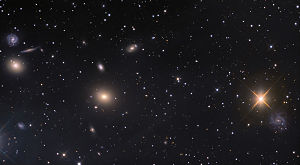NGC 1066
| Galaxy NGC 1066 |
|
|---|---|

|
|
| Panoramic image with a 60 cm telescope of the galaxies NGC 1057 , NGC 1060 , NGC 1061 , NGC 1066 and NGC 1067 (from right to left, NGC 1066 is on the left edge of the image, slightly below the center of the image) and other galaxies that are not in the New General Catalog are listed. | |
| AladinLite | |
| Constellation | triangle |
|
Position equinox : J2000.0 , epoch : J2000.0 |
|
| Right ascension | 02 h 43 m 49.9 s |
| declination | + 32 ° 28 ′ 30 ″ |
| Appearance | |
| Morphological type | E: / Sy2 |
| Brightness (visual) | 13.3 mag |
| Brightness (B-band) | 14.3 mag |
| Angular expansion | 1.7 ′ × 1.6 ′ |
| Position angle | 57 ° |
| Surface brightness | 14.2 mag / arcmin² |
| Physical data | |
| Redshift | 0.014497 +/- 0.000097 |
| Radial velocity | 4346 +/- 29 km / s |
|
Stroke distance v rad / H 0 |
(199 ± 14) · 10 6 ly (60.9 ± 4.3) Mpc |
| history | |
| discovery | William Herschel |
| Discovery date | September 12, 1784 |
| Catalog names | |
| NGC 1066 • UGC 2203 • PGC 10338 • CGCG 505-044 • MCG + 05-07-042 • IRAS 02407 + 3217 • 2MASX J02434989 + 3228295 • GC 598 • H III 163 • h 260 • LDCE 176 NED032 | |
NGC 1066 is an elliptical galaxy with an active nucleus of the Hubble type E1 in the constellation Triangle in the northern sky . It is estimated to be 199 million light years away from the Milky Way and has a diameter of about 100,000 ly.
In the same area of the sky there are also NGC 1062 , NGC 1067 and PGC 10331 .
The object was discovered on September 12, 1784 by the German-British astronomer William Herschel .
Web links
Commons : NGC 1066 - collection of images, videos, and audio files
